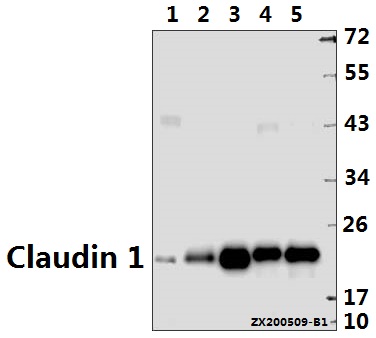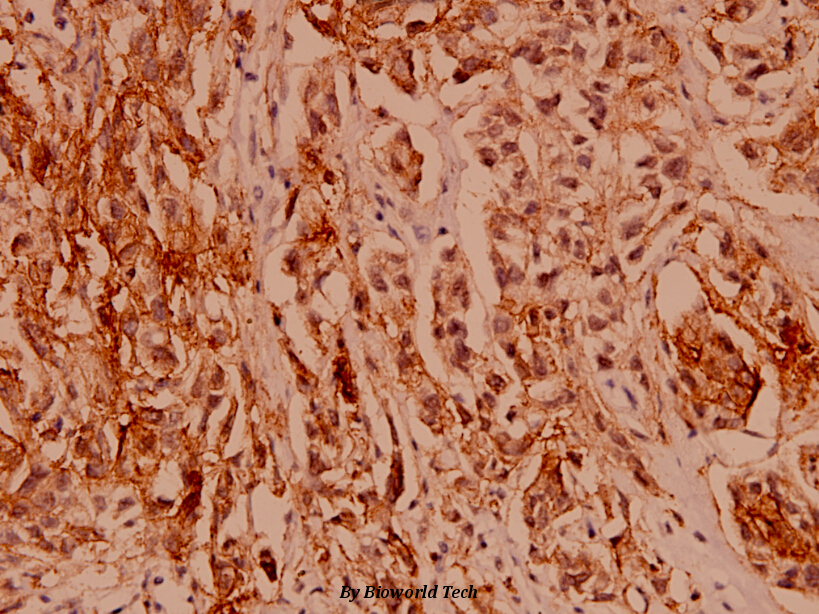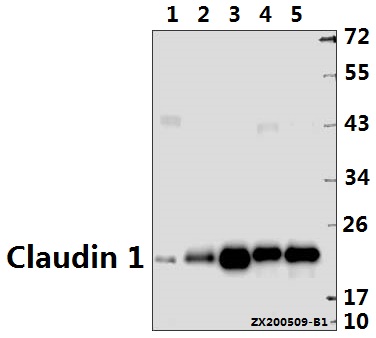Product Name :
Claudin 1 (R197) polyclonal antibody Background :
The claudin superfamily consists of many structurally related proteins in humans. These proteins are important structural and functional components of tight junctions in paracellular transport. Claudins are located in both epithelial and endothelial cells in all tight junction-bearing tissues. Three classes of proteins are known to localize to tight junctions, including the claudins, Occludin and junction adhesion molecule (JAM). Claudins, which consist of four transmembrane domains and two extracellular loops, make up tigh junction strands. Emerging evidence suggests that the claudin family of proteins regulates transport through tight junctions via differential discrimination for solute size and charge. Claudin expression is often highly restricted to specfic regions of different tissues and may have an important role in transcellular transport through tight junctions. Product :
Rabbit IgG, 1mg/ml in PBS with 0.02% sodium azide, 50% glycerol, pH7.2 Storage&Stability :
Store at 4°C short term. Aliquot and store at -20°C long term. Avoid freeze-thaw cycles. Specificity :
Claudin 1 (R197) polyclonal antibody detects endogenous levels of Claudin 1 protein. Immunogen :
Synthetic peptide, corresponding to amino acids 171-220 of Human Claudin-1. Conjugate :
Unconjugated Modification :
Unmodification
Claudin 1 (R197) polyclonal antibody Background :
The claudin superfamily consists of many structurally related proteins in humans. These proteins are important structural and functional components of tight junctions in paracellular transport. Claudins are located in both epithelial and endothelial cells in all tight junction-bearing tissues. Three classes of proteins are known to localize to tight junctions, including the claudins, Occludin and junction adhesion molecule (JAM). Claudins, which consist of four transmembrane domains and two extracellular loops, make up tigh junction strands. Emerging evidence suggests that the claudin family of proteins regulates transport through tight junctions via differential discrimination for solute size and charge. Claudin expression is often highly restricted to specfic regions of different tissues and may have an important role in transcellular transport through tight junctions. Product :
Rabbit IgG, 1mg/ml in PBS with 0.02% sodium azide, 50% glycerol, pH7.2 Storage&Stability :
Store at 4°C short term. Aliquot and store at -20°C long term. Avoid freeze-thaw cycles. Specificity :
Claudin 1 (R197) polyclonal antibody detects endogenous levels of Claudin 1 protein. Immunogen :
Synthetic peptide, corresponding to amino acids 171-220 of Human Claudin-1. Conjugate :
Unconjugated Modification :
Unmodification
-
 Western blot (WB) analysis of Claudin 1 (R197) pAb at 1:500 dilution Lane1:PC12 whole cell lysate(40ug) Lane2:The Liver tissue lysate of Mouse(40ug) Lane3:The Kidney tissue lysate of Rat(20ug) Lane4:L02 whole cell lysate(40ug) Lane5:H1792 whole cell lysate(40ug)
Western blot (WB) analysis of Claudin 1 (R197) pAb at 1:500 dilution Lane1:PC12 whole cell lysate(40ug) Lane2:The Liver tissue lysate of Mouse(40ug) Lane3:The Kidney tissue lysate of Rat(20ug) Lane4:L02 whole cell lysate(40ug) Lane5:H1792 whole cell lysate(40ug) -
 Immunohistochemistry (IHC) analyzes of Claudin-1 (R197) pAb in paraffin-embedded human breast carcinoma tissue at 1:100.
Immunohistochemistry (IHC) analyzes of Claudin-1 (R197) pAb in paraffin-embedded human breast carcinoma tissue at 1:100. -
 Immunohistochemistry (IHC) analyzes of Claudin-1 (R197) pAb in paraffin-embedded human breast carcinoma tissue at 1:100.
Immunohistochemistry (IHC) analyzes of Claudin-1 (R197) pAb in paraffin-embedded human breast carcinoma tissue at 1:100.
Identification of Claudins by Western Blot and Immunofluorescence in Different Cell Lines and Tissues
PMCID: Pubmed No.:21717359
Severe intraglomerular detachment of podocytes in a Gitelman syndrome patient
PMCID: Pubmed No.:22484642
The effect of phytic acid on tight junctions in the human intestinal Caco-2 cell line and its mechanism.
PMCID: Pubmed No.:26385515
Murine Double Minute-2 Inhibition Ameliorates Established Crescentic Glomerulonephritis
PMCID: Pubmed No.:27102769
The effect of phytic acid on tight junctions in the human intestinal Caco-2 cell line and its mechanism.
PMCID: Pubmed No.:26385515
Murine Double Minute-2 Inhibition Ameliorates Established Crescentic Glomerulonephritis
PMCID: Pubmed No.:27102769
Atorvastatin alleviates microglia-mediated neuroinflammation via modulating the microbial composition and the intestinal barrier function in ischemic stroke mice
PMCID: Pubmed No.:33279615
Parasympathectomy increases resting secretion of the submandibular gland in minipigs in the long term
PMCID: Pubmed No.:30387129
CTRP3 promotes TNF-α-induced apoptosis and barrier dysfunction in salivary epithelial cells
PMCID: Pubmed No.:33991612
Expression patterns of tight junction proteins in porcine major salivary glands: a comparison study with human and murine glands
PMCID: Pubmed No.:29851087
Disruption of tight junctions contributes to hyposalivation of salivary glands in a mouse model of type 2 diabetes
PMCID: Pubmed No.:32374057
Alteration of tight junctions during botulinum toxin type A-inhibited salivary secretion
PMCID: Pubmed No.:35472254
Bioworld Biotech only provide peptides for our antibodies and do not provide additional peptide customization services.
Price/Size :
USD 368/1mg/vial
Tips:
For phospho antibody, we provide phospho peptide(0.5mg) and non-phospho peptide(0.5mg).Describe :
Blocking peptides are peptides that bind specifically to the target antibody and block antibody binding. These peptide usually contains the epitope recognized by the antibody. Antibodies bound to the blocking peptide no longer bind to the epitope on the target protein. This mechanism is useful when non-specific binding is an issue, for example, in Western blotting (WB) and Immunohistochemistry (IHC). By comparing the staining from the blocked antibody versus the antibody alone, one can see which staining is specific; Specific binding will be absent from the western blot or IHC performed with the neutralized antibody.Formula:
Synthetic peptide was lyophilized with 100% acetonitrile and is supplied as a powder. Reconstitute with 0.1 ml DI water for a final concentration of 10 mg/ml.The purity is >90%,tested by HPLC and MS.
Storage:
The freeze-dried powder is more stable. For short time at 2-8°C. For long term storage store at -20°C.
Note :
This product is for research use only (RUO only). Not for use in diagnostic or therapeutic procedures.
 Claudin 1 (R197) polyclonal antibody
Claudin 1 (R197) polyclonal antibody  Datasheet
Datasheet COA
COA MSDS
MSDS SHIP
SHIP